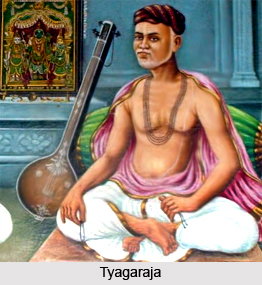 History of Tanjore in the lyrics of Thyagaraja has been portrayed as one of the beautiful places for musical flourish. Carnatic Music is the classical art-music of south India. It is simultaneously a virtuoso performance tradition of absolute music revelling in pure sound and a devotion tradition in which Sahityam (text) is extremely important. In the academic field of musicology the acquisition of musical knowledge is assessed through a pattern of objectification. Music historians recognize the fact that music composers are like musical chroniclers. The composer remains as a subjective agency behind his work.
History of Tanjore in the lyrics of Thyagaraja has been portrayed as one of the beautiful places for musical flourish. Carnatic Music is the classical art-music of south India. It is simultaneously a virtuoso performance tradition of absolute music revelling in pure sound and a devotion tradition in which Sahityam (text) is extremely important. In the academic field of musicology the acquisition of musical knowledge is assessed through a pattern of objectification. Music historians recognize the fact that music composers are like musical chroniclers. The composer remains as a subjective agency behind his work.
Thyagaraja is a legendary musician-saint who was born on 4 May 1767 at Tiruvauir, Tanjore district, Tamil Nadu. Giriraja Kavi, his grandfather hailed from Kakarla village, Cumbum Taluk, Kurnool district, Andhra Pradesh. Kavi, was a Sanskrit poet at the court of Sahaji (AD 1684-1712), the Maratha ruler of Tanjore (Thanjavur). Rama Brahmam, father of Thyagaraja was an expounder of the Ramayana in the court of the Maratha ruler Tulaja II (AD 1763-87). Convention clubs Thyagaraja, Muthuswami Dikshitar and Syama Sastri into a single expression - `Musical Trinity`. They are also known as `Sangita Trimurties` and `Sangita Mummanigal`. Thyagaraja is the foremost of the `Trinity`, and his time coincides with that of Tulaja II and Sarabhoji II.
Luckily, for the purpose of reference, the compositions of Thyagaraja, about 700 in number (in Telugu language and Sanskrit language) are available. They are to be primarily classified as Bhakti literature. They contain incidental references, which are to be culled, sifted and assorted to serve as historical source materials. Needless, to add, they suffer from all the deformities, customarily associated with historical literary sources. The musicologist looks to the historian to clarify the reliability of the compositions.
However, there is no dearth of source material to highlight the history of Tanjore (Thanjavur) during the interval AD 1763 to 1850. In AD 1799 (on 22 October), the British East India Company took over the direct administration of Tanjore principality.
This article is a stub. You can enrich by adding more information to it. Send your Write Up to content@indianetzone.com




















